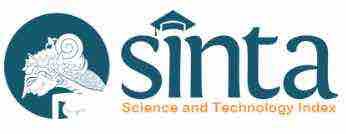IMPLEMENTASI ALGORITMA K-MEDOIDS UNTUK CLUSTERING WILAYAH TERINFEKSI KASUS COVID-19 DI DKI JAKARTA
Abstract
Full Text:
PDFReferences
Agus, P. (2017). Implementation of Data Mining on Rice Imports by Major Country of Origin Using Algorithm Using K-Means Clustering Method. International Journal Of Artificial Intelligence Research, 1(2), 26–33
Arbin, N., Suhaimi, N. S., Mokhtar, N. Z., & Othman, Z. (2016). Comparative analysis between k-means and k-medoids for statistical clustering. Proceedings - AIMS 2015, 3rd International Conference on Artificial Intelligence, Modelling and Simulation, 117–121. https://doi.org/10.1109/AIMS.2015.82
Darmi, Y. D., & Setiawan, A. (2016). Penerapan Metode Clustering K-Means Dalam Pengelompokan Penjualan Produk. Jurnal Media Infotama, 12(2). https://doi.org/10.37676/jmi.v12i2.418
Nasari, F., & Sianturi, C. J. M. (2016). Penerapan Algoritma K-Means Clustering Untuk Pengelompokkan Penyebaran Diare Di Kabupaten Langkat. CogITo Smart Journal, 2(2), 108. https://doi.org/10.31154/cogito.v2i2.19.108-119
Noviyanto, N. (2020). Penerapan Data Mining dalam Mengelompokkan Jumlah Kematian Penderita COVID-19 Berdasarkan Negara di Benua Asia. Paradigma - Jurnal Komputer Dan Informatika, 22(2), 183–188. https://doi.org/10.31294/p.v22i2.8808
Pulungan Nurliana, suhada, S. D. (2019). Penerapan Algoritma K-Medoids Untuk Mengelompokkan Penduduk. KOMIK (Konferensi Nasional Teknologi Informasi Dan Komputer), 3(1), 329– 334. https://doi.org/10.30865/komik.v3i1.16
Sadewo, M. G., Windarto, A. P., & Wanto, A. (2018). Penerapan Algoritma Clustering Dalam Mengelompokkan Banyaknya Desa/Kelurahan Menurut Upaya Antisipasi/ Mitigasi Bencana Alam Menurut Provinsi Dengan K-Means. KOMIK (Konferensi Nasional Teknologi Informasi Dan Komputer), 2(1). https://doi.org/10.30865/komik.v2i1.943
Sindi, S., Ningse, W. R. O., Sihombing, I. A., Ilmi R.H.Zer, F., & Hartama, D. (2020). Analisis algoritma K-Medoids clustering dalam pengelompokan penyebaran Covid-19 di Indonesia. Jti (Jurnal Teknologi Informasi), 4(1), 166–173
Velmurugan, T., & Santhanam, T. (2010). Computational complexity between K-means and K-medoids clustering algorithms for normal and uniform distributions of data points. Journal of Computer Science, 6(3), 363–368. https://doi.org/10.3844/jcssp.2010.363.368
Wira, B., Budianto, A. E., & Wiguna, A. S. (2019). Implementasi Metode K-Medoids Clustering Untuk Mengetahui Pola Pemilihan Program Studi Mahasiwa Baru Tahun 2018 Di Universitas Kanjuruhan Malang. RAINSTEK : Jurnal Terapan Sains & Teknologi, 1(3), 53–68. https://doi.org/10.21067/jtst.v1i3.3046
Yunus NR, & A, R. (2020). Kebijakan Pemberlakuan Lock Down Sebagai Antisipasi Penyebaran Corona Virus Covid-19. Salam: Jurnal Sosial Dan Budaya Syar-I, 7(3), 227–238. http://journal.uinjkt.ac.id/index.php/salam/article/v iew/15083
DOI: https://doi.org/10.31884/jtt.v7i2.353
Refbacks
- There are currently no refbacks.
Copyright (c) 2021 JTT (Jurnal Teknologi Terapan)

This work is licensed under a Creative Commons Attribution-NonCommercial-NoDerivatives 4.0 International License.
 Creative Common Attribution-ShareAlike 4.0 International (CC BY-SA 4.0)
Creative Common Attribution-ShareAlike 4.0 International (CC BY-SA 4.0)














